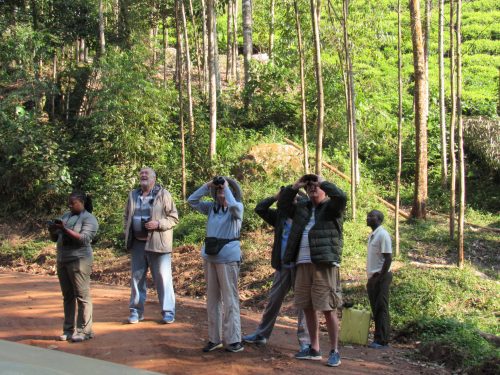Bird Watching
Home / Things to do in your Africa Tour | Uganda Tour / Activities /
Bird Watching In Uganda
During your birding Safari or bird-watching safari in Uganda, Outback Adventure Safaris will take you through some spectacular bird-watching tour sites for your perfect Uganda bird-watching tour and holiday.
Uganda boasts of an incredible bird list with about 1046 recorded and confirmed species of birds, representing over 10% of the world’s bird list and over 50% of all the birds found on the African continent.
Though not holding many country endemics, the unusually high number of bird species per square kilometer, and the ease of the variably lush vegetation make Uganda amongst the top birding destinations in the whole world. For all those taking their first birding trip outside the Americas, Europe, or Asia, you will most likely double your life list of birds.
Our Bird-watching trips can ably cater to small groups of only 6-8 participants. Quality is paramount to us – we prefer to use superior accommodation (where available at the top birding sites) and vehicles. Despite our focus on small groups and the fact that we focus on superior quality, our prices are competitive.
Uganda, the Pearl of Africa has earned the name of a Birder’s haven with an estimate of 1,067 species of birds beating the US and Europe combined. A regional awareness event called the African Birding Expo is normally organized in mid-November at Entebbe Botanical Gardens in Entebbe, attracting thousands of avid tourists from around the world.
Such events are aimed at cultivating a bird-watching culture in schools and homesteads so that they create a bigger bird-watching community both locally and internationally. The Government of Uganda is currently targeting close to 100,000 avian tourists per year for the next 10 years, to reap several benefits for the local tourism industry.
NATURE OF OUR UGANDA BIRD-WATCHING SAFARIS
Our primary focus is to locate important bird species, especially endemics, migratory birds, and specials. We understand that birding tours can be exhausting, so we prefer to add an extra day or two to make your Uganda birding experience less tiring and more enjoyable. This backup time not only allows us to stop for mammals and other interesting things along the way but also gives us time in case some birds fail to appear as expected.
We also conduct Uganda Birding Photo Tours, which require a different approach than typical birding tours. We provide more space in the vehicles for camera gear, maintain the correct tour pace for great photo shots, angle the vehicle correctly, and constantly think about lighting.
When you contact us, you will find our team to be highly enthusiastic and efficient at sharing detailed information with you. Our contagious enthusiasm for birding and the natural world as a whole spurs us to provide outstanding service. We offer bird-watching trips for beginners, intermediate, and advanced birders on birding tours to many countries.
Birding at Mabamba Ramsar Wetland Site (IBA)
The Mabamba Ramsar wetland site is not only an important birding area (IBA) in Uganda, but it is also a wetland of International Importance. The wetland bay is situated on the edge of Lake Victoria, within the peri-urban areas of Entebbe in Kasanje Sub-county, Wakiso District, at the western part of the Entebbe Peninsula.
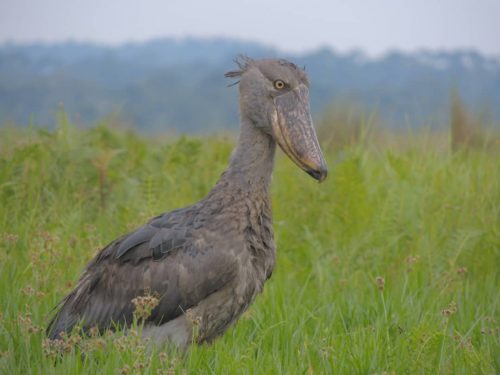
Mabamba Swamp is a habitat for various bird species, including the rare Shoebill stock bird. It is also home to nearly 300 marine bird species, both native and migratory, such as the Papyrus Gonolek – a papyrus endemic bird – and the Blue Swallow, which migrates from South Africa. Additionally, the wetland is known for the Sitatunga, the only animal found in this area.
Access to the Mabamba Bay shoebill tracking site and the general Mabamba Ramsar wetland is by Canoe Boats or Ferry services through the Nakiwogo Fishing and Landing site.
From visitors’ tourists or birding, visitors take a 15-minute boat ride to Kyanvubu Swamp Bay (Buwaya Fish Landing site) where they take a car drive for approximately 45 minutes to the Ramsar site in Mabamba.
Other species of interest at Mabamba include the malachite Kingfisher, Africa Jacana, Lesser Jacana, Purple Heron, Squacco Heron, Swamp Flycatcher, Black Crake, Fan Tailed Widow Bird, Long Toed Lapwing, Africa marsh Harrier, African Fish Eagle, Northern Brown-throated Weaver, Osprey, Palm Nut Vulture among other species.
When you visit Mabamba, you can enjoy marine boat rides, track shoebills, go on nature walks, and spot rare Lake Victoria water birds like the Papyrus Gonolek and Blue Swallow.
Nkima Forest Lodge Mabamba
This site is located in the southern part of Entebbe, situated in an indigenous forest on Nansubuga Hill overlooking Mabamba Bay Wetlands (IBA). The area is a birding hotspot in Uganda, given its natural botanic setting, making it a sanctuary for forest bird species.
Prominent bird species at Nkima Forest Lodge include the Western Banded Snake Eagle, Brown Snake Eagle, Black and White Casqued Hornbill, Great Blue Turaco, Little Green Bill, White-spotted Flufftail, White-browed Robin-chat, and Red-headed Lovebird, among others.
In addition to the numerous bird species, Nkima Forest, as the name suggests, is home to Primate Monkey Habitats, notably the Red-tailed Monkey, Vervet Monkey, and Black and White Colobus Monkey. The forest is also home to a variety of butterflies, insects, and small mammals like squirrels, mongoose, bushbucks, and others.
If you’re a bird enthusiast, you may enjoy birding at Makanaga Wetland.
Makanaga Wetland
The Makanaga Wetland is located adjacent to Lake Victoria along Masaka Road with incredible bird viewing sites for the most sought-after Shoebill Stork bird as well as a variety of water-habitant birds.
Makanaga Wetland is one of the few known birding sites in Uganda offering a good viewing opportunity of one of Uganda’s most sought-after birds; The Shoebill.
The Shoebill is the main attraction at Makanaga Wetland while other species include; Spur-winged goose, wood and common sandpiper, yellow-billed duck, white-faced whistling duck, black-winged stilt, long-tailed and Great cormorants, Spur Winged Lapwing, Little and Great Egret, Thousands of Cull-billed Terns, Black-winged Terns and Grey-headed gulls among other bird species.
Birding at Entebbe Botanical Garden
The Entebbe Botanical Gardens, established in 1898, are located on the northern shores of Lake Victoria in Entebbe municipality.
The gardens cover an area of 40.7 hectares and feature a wide collection of tropical, sub-tropical, and temperature zones trees, shrubs, and other botanical flora and plants naturally regenerated throughout the year.
Bird-watching tours are available in the mornings and evenings, providing an introduction to Uganda’s afro-tropical bird species. The gardens are an ideal destination for birding, with Palm-nut vultures and grey parrots as residents, and the main attractions being the Great Blue Turaco and Ross’s Turaco.
The gardens host nearly 431 species of trees, of which 199 are indigenous to Uganda, 122 are of medicinal value, and 110 are exotic species.
The gardens are situated close to the Entebbe Botanical Beach Hotel where you can find three species of monkey primates, including the Vervet Monkey, Reptile Monkey, and Black and White Colobus Monkey. Besides bird-watching, visitors can participate in various activities such as biking, nature walks, music festivals, monkey feeding, games, camping, and more.
You can contact us to learn about other activities you can enjoy as well.
Some other bird species of interest at the Entebbe Botanical Gardens include the Grey Parrot, Bat Hawk, Palm Nut Vulture, Orange Weaver, Grey Plantain Eater, African Paradise Flycatcher, and Red-Bellied Paradise Flycatcher, among others.
Lutembe Ramsar Wetland Bay (IBA)
Lutembe Bay, located at the edge of Lake Victoria, is a Ramsar wetland of international importance, and also one of Uganda’s 33 IBA.
The birding site can be accessed via Entebbe Main highway in Katabi Town Council, Wakiso District, but admission is required.
The bay is renowned for its population of up to 1.5 million white-winged terms and has been hosting native and Palearctic migrant birds for centuries.
The bay is a crucial stopover for migratory birds from the southern hemisphere and is considered one of the most remarkable bird-watching sites in the Lake Victoria Basin.
It is home to various species, including Hottentot Teal, Caspian Tern, Temminck’s Stint, and many others.
The Lutembe birding site is a host to both residents and millions of Palearctic migrants, particularly the vast flocks of white-winged terns and grey-headed gulls.
Bird watching At Lake Mburo National Park
Lake Mburo National Park is an absolute must-visit destination for bird enthusiasts! With an impressive 313 different species, including 8 of the 12 species found in the Lake Victoria Basin biome in Uganda, this park is a bird-watcher’s paradise. The elusive Shoebill stork and the White-winged Warbler are just two of the many highlights that you won’t want to miss.
But don’t just take my word for it – the park is also famous for its biodiversity of animal and plant life, which can be best viewed on a boat trip. Get ready to see crocodiles, hippopotamuses, and a wide variety of bird species, including pelicans, black crake, common squacco, striated, goliath, purple, black-headed, grey, and black-headed herons, great white and pink-backed cormorants, the African fish eagle, shoebill, and more!
If you’re looking for the best bird-watching spots in Lake Mburo National Park, we’ve got you covered. Head to the swampy valleys of Warukiri and Miriti, or check out the roadsides between Rwonyo camp and the Jetty. You can also visit perfectly situated viewing platforms at the Salt Lick, Miriti Valley, and Rubanga Forest, where you can observe a variety of species, including the Rufous-bellied Heron, Bateleur, Coqui Francolin, Grey Crowned Crane, Black-bellied Bustard, Brown-chested Lapwing, Emerald-spotted Wood-Dove, Brown Parrot, Red-headed Lovebird, Ross’s Turaco, Bare-faced Go-away-bird, Green Wood-hoopoe, Common Scimitar bill, White-headed Barbet, Red-faced Barbet, Nubian Woodpecker, Red-shouldered Cuckoo-shrike, Long-tailed Cisticola, Yellow-breasted Apalis, White-winged Tit, Finfoot, and many more.
Don’t miss out on this epic bird-watching trip! Contact us today to plan your unforgettable adventure to Lake Mburo National Park.
Murchison Falls National Park
This includes Murchison Falls National Park and the Budongo Forest extension. The park alone is home to over 460 bird species including the peculiar shoebill stork that is usually seen on a boat ride along the marshy stretch of the Nile River towards the Delta.
Birds like Abyssinian ground hornbill, Verreaux’s Eagle-owl. Marsh tchagra, pennant-winged nightjar, African crake, red-throated bee-eater, standard-winged nightjars, Speckle-breasted woodpecker, standard-winged nightjar, bronze-tailed glossy starling, dusky babbler, yellow-bellied hyliota, Brown-rumped bunting, Heuglin’s masked weaver, black-backed cisticola, orange- winged pytilia, parasitic weaver, ring-necked francolin, and a wide variety of raptors and water birds are found here.
Bird watching in Semliki National Park
This lowland tropical rainforest is popular for attracting and hosting the eastern Congo Ituri forest species.
Most species found in Semuliki National Park are not well represented in any other Ugandan lowland forests.
The most interesting bird species here include among others; Crested Malimbe, capuchin babbler, Zenker’s honeyguide, Chestnut-bellied helmet shrike, Bates nightjar, red-eyed puff back, Hartlaub’s duck, yellow-throated nicator, Xavier greenbul, swamp palm greenbul, chestnut owlet, eastern-bearded greenbul, fiery- breasted bush-shrike, forbe’s plover, Gabon Woodpecker, grant’s bluebill, Grauer’s cuckoo-shrike, long-tailed hawk, orange-tufted sunbird, pale-fronted negrofinch, red-bellied malimbe, Sassi’s olive greenbul, dusky nightjar, spotted honeyguide, white-crested hornbill, and white-bellied kingfisher.
Bird watching in Kibale Forest National Park
Home to 13 primate species including the chimps, Kibale is another excellent hub to spot many birds including some of the Albertine rift regional endemics.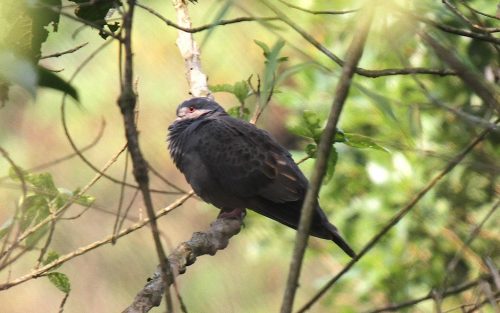
The stunning black bee-eater, Nahan’s francolin, Cassin’s spine tail, green-breasted pitta, African Pitta, Abyssinian ground thrush, Red-winged francolin, Black-eared ground thrush, Red-faced crimsoning, grey-headed olive back, speckle-breasted woodpecker, white-naped pigeon, black-bellied seed cracker, white-collared olive back are some of the bird species one should look for in this forest.
Queen Elizabeth National Park
Queen Elizabeth National Park boasts of having the richest biodiversity of any other national reserve in Africa.
It is the second biggest after the Murchison Falls conservation area with the highest number of recorded bird species of all the African national parks and most probably the whole world, with a total of more than 611 bird species.
It is home to 54 raptors and hosts every water bird found in Uganda, including savanna, woodland, and forest birds. The rare Baudouin’s snake-eagle, broad-tailed paradise whydah, collared palm-thrush, semi-collared flycatcher, Wahlberg’s honey-guide, Caspian Plover, speckle-breasted woodpecker, Blue Quail, fan-tailed grass-bird, short-tailed pipit, Lowland akalat, Madagascar lesser cuckoo, striped crake, yellow-bellied wattle-eye, Madagascar pond heron, etc. are all found here.
Birding in Bwindi Impenetrable Forest National Park
Bwindi Impenetrable National Park takes pride in its total of 357 bird species recorded; 23 of which are endemic to the Albertine Rift, and 14 species recorded nowhere else among them are the brown-necked parrot, African green broadbill, white-bellied robin chat, African Broadbill, Shelley’s Crimsoning, dusky long-tailed cuckoo, yellow-footed flycatcher, purple-breasted sunbird, Lagdens Bush-shrike, dusky crimsoning, dwarf honeyguide, Oberlander’s ground thrush, Kivu ground thrush, papyrus yellow warbler, African green-broadbill, Grauer’s rush warbler, purple-breasted sunbird, short-tailed warbler, white-tailed blue flycatcher and Frazer’s eagle owl.
The park is a UNESCO World Heritage Site partly because of inhabits half of the world’s only remaining mountain gorillas.
Bird watching at Budongo Forest Reserve
Budongo Forest is famous for providing prime forest birding in the whole of Africa. Birding along the Royal Mile has been rated by many as the number one birding spot in the entire African continent.
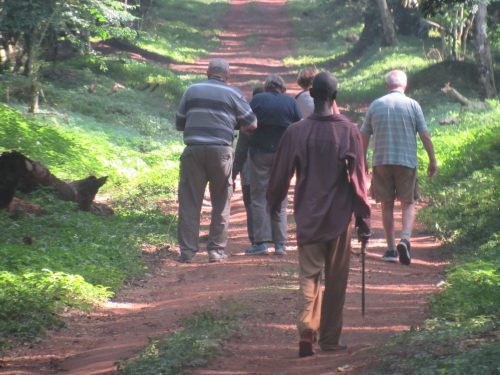
Walking through mixed flocks of African greenbuls, skulking alethes, and the elusive illadopses is so fascinating. Xavier’s greenbul, Madagascar lesser cuckoo, Black-shouldered nightjar, Nahan’ Francolin, Puvel’s Illadopsis, crested francolin, chocolate-backed kingfisher, and Ituri batis are among the many specialties found here.
The Kanio Pabidi and the Busingiro sections of the Budongo Forest reserve are far more rewarding.
Birding in Kidepo Valley National Park
Uganda’s untapped wilderness spectacle of unique habitats with associated fauna and flora. Driving through this park is like exploring the Masai Mara and the Serengeti of 100 years ago.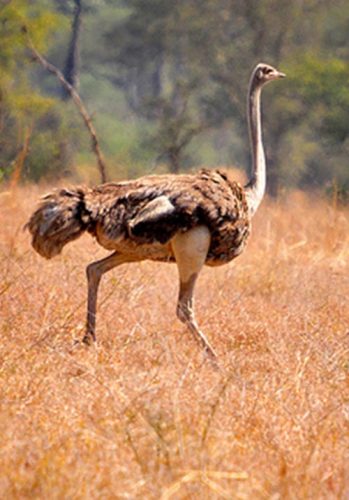
The bird life in Kidepo Valley National Park is rich with a recorded bird list of 486. There are over 60 bird species listed here and have not been recorded in any other Ugandan National Park.
Kidepo National Park is outstanding for its birds of prey of 58 species recorded, 14 are believed to be endemic to the region.
Among those are Verreaux’s eagle, Egyptian vulture, lesser Kestrel, and pygmy falcon. Other interesting species include birds like the Karamoja Apalis, Kori bustard, red-billed hornbill, yellow-billed and Jackson’s hornbill, Abyssinian nightjar, brown-rumped bunting, Quail plover, Black-breasted Barbet, black-faced firefinch, brown-backed woodpecker, Clapperton’s francolin, Emin’s shrike, heuglin’s wheatear, Jameson’s firefinch, orange-winged pytilia, red-winged pytilia, ring-necked francolin, swallow-tailed kite, and three-streaked chakra.
Other Birds watching Destinations in Uganda include Maramagambo Forest, Mgahinga Mountain National Park for the stunning Rwenzori Turaco;
Bird watching at Mabira Central Forest Reserve
Mabira Central Forest Reserve is one of Uganda’s largest surviving Natural Forests covering an area of 306 sq. km.
The forest is a natural habitat of 312 species of trees including the Diphasia angiogenesis which is not known elsewhere in Uganda and five species that are of international conservation concern, the Cordia Millenii, Militia Excelsa, Irvingia gabonensis, Entandrophragma angolense, and Lovoa swynnertonii. The Warbhugia Ugandenesis has medicinal properties and is known to cure over forty ailments; the vulnerable prunus Africana are also here.
Mabira is the most significant forest reserve in central region Uganda with a close to the capital city and is a habitat to over 315 bird species on record with 74 of the 144 species of the Guinea-Congo Forests biome that occurs in Uganda.
Mabira Central Forest Reserve hosts some of the Eastern Congo Biome Species. The forest has well-established birding trails that include the Red-tailed Monkey, Turaco and the Buttress trails will ease life for you in your search for Nahan’s Francolin which is an IUCN Red list’ endangered species, Cassin’s Hawk-eagle, White-spotted Flufftail, Afep Pigeon, Grey Parrot, Dusky Long-tailed Cuckoo, Black-shouldered Nightjar, Sabine’s Spinetail, Cassin’s Spinetail, Blue-throated Roller, African Dwarf-kingfisher, White-bellied Kingfisher, Forest Woodhoopoe, African Pied Hornbill, Black-and-white-casqued Hornbill, Speckled Tinkerbird, Yellow-throated Tinkerbird, Yellow-spotted Barbet, Hairy-breasted Barbet, Yellow-billed Barbet, Green-breasted Pitta, African Shrike-flycatcher, Jameson’s and Chestnut Wattle-eyes, the Forest Robin, Fire-crested Alethe, Red-capped Robin-Chat, the Speckle-breasted, Yellow-crested, Brown-eared, Grey and the Buff-spotted Woodpeckers, Cassin’s Honeyguide, Red-tailed Bristle bill, Little Greenbul, Honeyguide Greenbul, Sooty Boubou, Grey-green Bush-shrike, just to mention but a few.
Outback Top Safari Suggestions
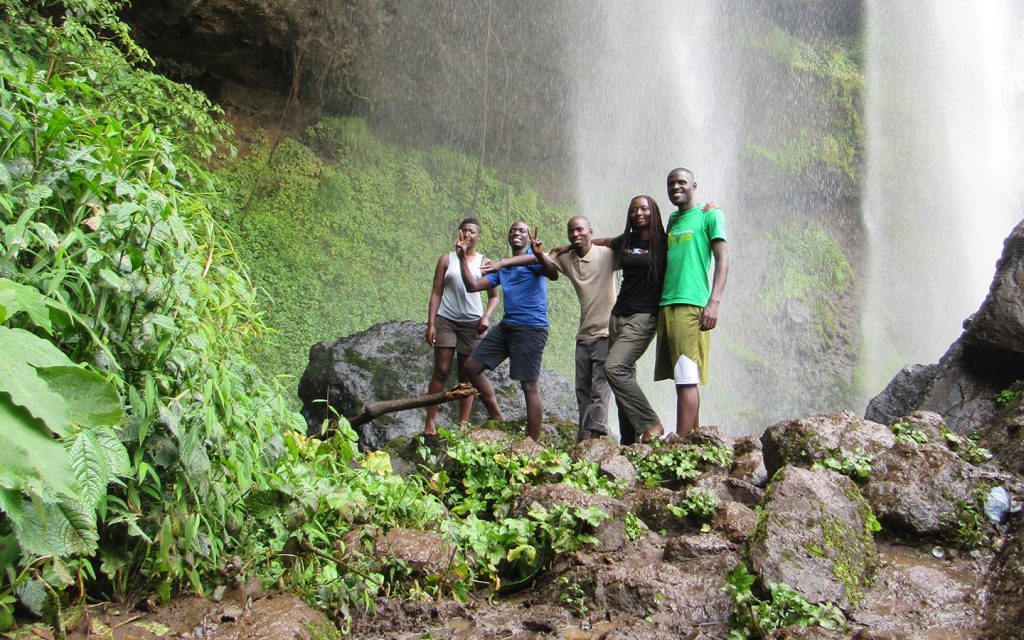
Pian Upe Game Reserve & Sipi Falls safari
This tour is takes you to the Eastern Uganda combining both Sipi Falls and Pian Upe game reserve.
4 Days, 3 Nights
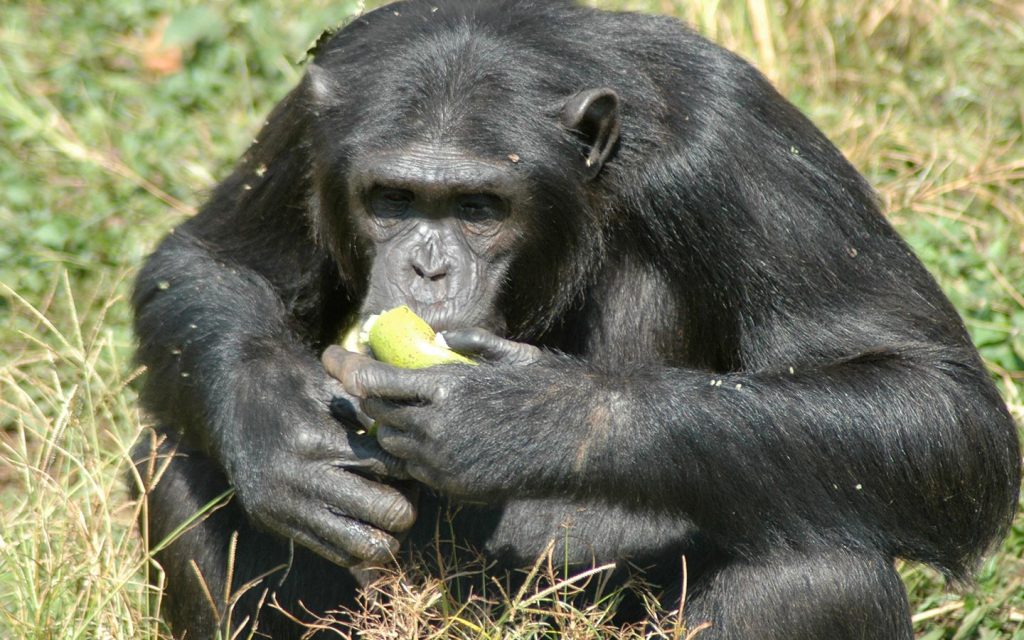
Uganda Gorilla and Chimp Habituation Safari
Have a chance to track and encounter the magnificent mountain gorillas in their habitat
5 Days, 4 Nights
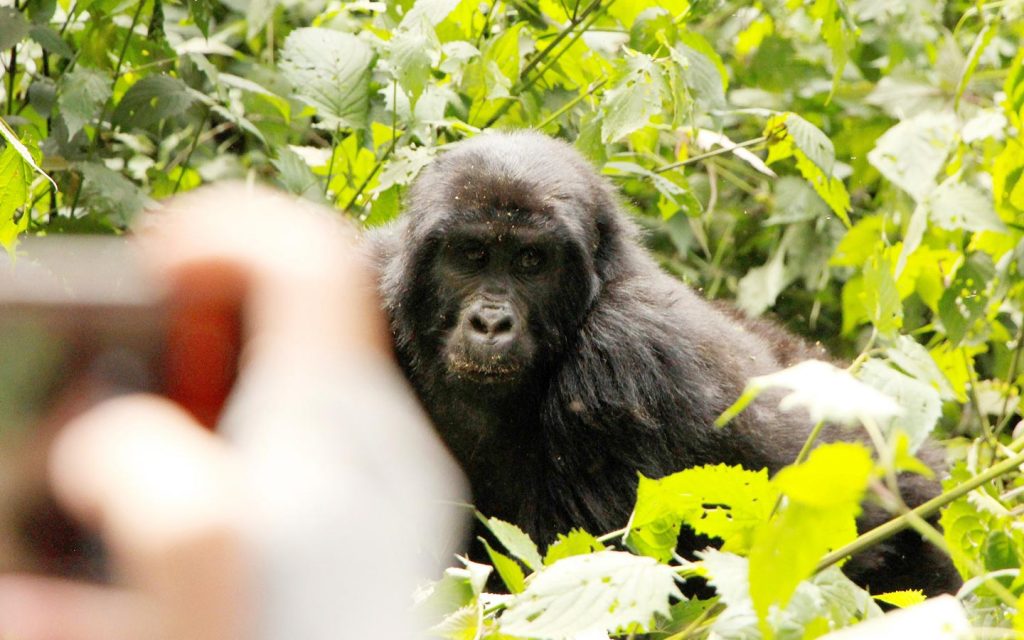
Uganda Gorilla & Golden Monkey Tracking Tour
Visit Mgahinga Gorilla National park for Golden monkey tracking experience.
4 Days, 3 Nights
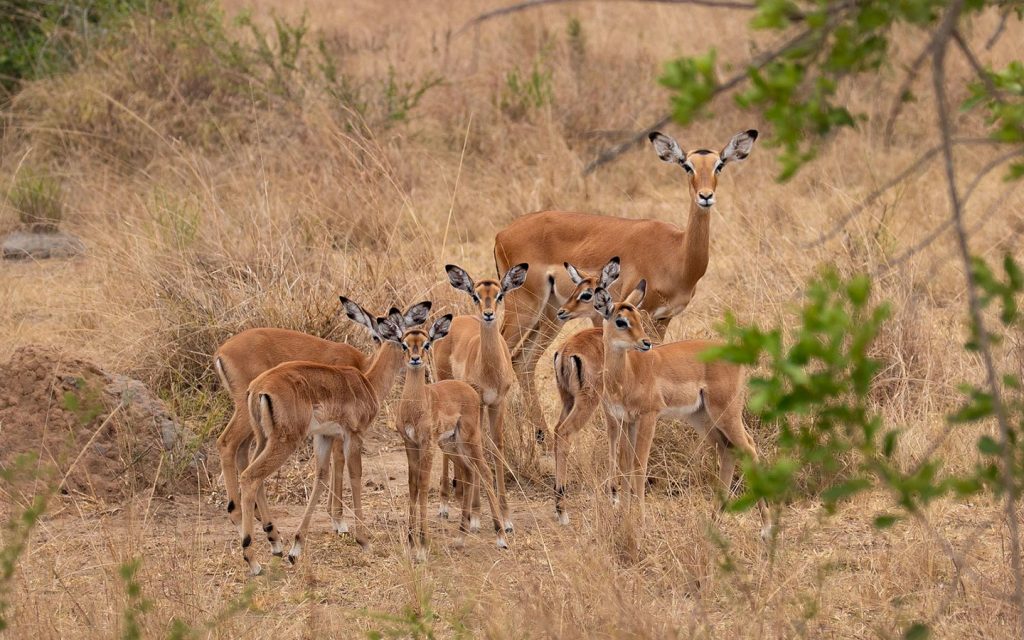
Uganda Primate Tracking & Game Safari
This tour gives you an extraordinary feeling being with these beautiful Creatures.

